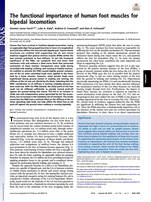|
Study Title:
Middorsal Wrist Pain in the High-Level Athlete: Causes, Treatment and Early Return to Play Authors: Hanson, ZC and Lourie, GM.. Publication Information: Orthopaedic Journal of Sports Medicine (2022) Vol. 10: 4. Background Information: Wrist injuries in high-level athletes, although common, often lack the attention or urgency for care as do injuries in the shoulder, knee and ankle. The evaluation, triage and management of these injuries are relatively standard, particularly those sustained acutely. And unlike radial and ulnar sided wrist injuries, an understanding of middorsal injuries could be improved. Wrist injuries specific to this location often present as early insidious discomfort that, with examination and care that lack detail, leads to lingering pain and inability to perform. This open access paper reviews the differential diagnoses of middorsal wrist pain in high-level athletes, along with treatment and return to play and is summarized below. Do note that this summary does not include my own personal thought processes (i.e. assessment upstream) and choices for plan of management (i.e. manual therapies and/or exercise rehabilitation strategies). Summarizing this paper was simply a means for me to keep myself abreast of the multitude of possibilities when presented with athletes experiencing middorsal wrist pain. TRAUMATIC AND OVERUSE INJURIES Scapholunate Ligament Injuries
Second and Third Carpometacarpal Injuries
Distal Radial Physeal Stress Syndrome
Avascular Necrosis of the Lunate
TENDINOPATHY AND TENDON INSTABILITY Extensor Pollicis Longus Tenosynovitis
Extensor Carpi Radialis Brevis Insertional Tendinitis
Fourth-Compartment Syndrome: Anomalous Muscles and Tenosynovitis
DORSAL IMPINGEMENT SYNDROMES Dorsal Capsular Impingement
Occult Dorsal Carpal Ganglion
Dorsal Posterior Interosseous Nerve Syndrome
Personal Thoughts: It is clear that structures within this region are numerous and nuanced. It should also be clear that specificity of management warrants specificity of diagnosis. As such, it is incumbent upon ourselves as clinical practitioners to have a detailed understanding of the differential diagnoses within this region regardless of our scope of practice. And although many more differentials exist in the areas surrounding the middorsal region, as well as those pertaining to non-traditional orthopaedic pathways, this paper provides us with a good overview to help maintain a vast array of possible scenarios when presented with wrist pain in high level athletes.
0 Comments
Study Title: Stiffness of the human foot and evolution of the transverse arch Authors: Venkadesan, M. et al. Publication Information: Nature (2020) Vol. 579: 97-100. Background Information: The importance of midfoot stiffness for propulsion of human locomotion has been extensively studied. Much of the research however, has centered around the role of the medial longitudinal arch, with little investigation into the role of the transverse tarsal arch (TTA). Considering a model similar in conceptualization to that of the increasing stiffness properties of a sheet of paper when curled longitudinally, the role of the TTA in contributing to midfoot stiffness via bony and soft tissue configuration can be similarly applied. The purpose of this study was to examine the relationship between curvature and stiffness of the TTA. Study Methods: The TTA was modelled during both computer simulations and physical experiments. Three-point bending tests were performed on arched continuum shells, mechanical mimics of the midfoot, and on human cadaveric feet. Results: Shells with greater transverse curvature were found to be stiffer in longitudinal bending. Noted was that stiffness also depended the thickness, length, width, Young’s modulus, and Poisson’s ratio of the material. The three-point bending tests on the foot models (3 metatarsals with springs mimicking intermetatarsal tissues plus hinges towards the midfoot), demonstrated results similar to the shells based on degree of transverse curvature. The cadaveric feet demonstrated that intermetatarsal tissues significantly contributed to foot stiffness and greater than that of the longitudinal arch (LA) and plantar fascia. Conclusions: The structural curvature of the TTA, as well as the stiffness and slack contributed by intermetatarsal tissues, were found important for the longitudinal stiffness of the foot. Thus, the authors demonstrated that biomechanical understanding of the feet should expand beyond that of the longitudinal arch and include that of the transverse arch and its related soft tissues. Personal Interpretation and Significance: Like demonstrated in previous studies, it is important for us to look beyond static architecture of the foot and more toward the role dynamic activity plays in arch stiffness. Through this study, it is apparent that we must look at multiple planes and not ignore the role that soft tissues play in contributing to human locomotion.  Study Title: The functional importance of human foot muscles for bipedal locomotion Authors: Farris, DJ. et al. Publication Information: PNAS (2019) Vol. 116: 5. 1645-1650. Background Information: One of the most significant developments in the evolution of the human foot is replacement of an opposable first digit in favor of a longitudinal arch (LA). Research has shown that the purpose of this LA, via the restructuring of the bones within the foot, is to stiffen the foot to enable bipedalism by providing leverage for propulsion to the ground. It has also been demonstrated that the LA exhibits elastic mechanics and is able to act in a spring-like manner to minimize energy cost in running. Recent research has since focused on the intrinsic muscles of the feet, investigating their role in supportive foot mechanics during static and dynamic weightbearing. The purpose of this study was to test the importance of the plantar intrinsic muscles (PIMS) for stiffening of the foot, for providing LA support, and for propulsion generation during walking and running. Study Methods: Two experiments were performed in which posterior tibial nerve blocks were used to prevent PIM activation in each. The first experiment examined controlled loading of the lower leg via linear actuator with and without nerve block. The second experiment examined walking and running on a treadmill with and without nerve block. The effect of the nerve block on LA deformation was measured by changes in the Cal-Met angle formed between the calcaneus and metatarsal segments. Results: - There was a significant effect on LA deformation via nerve block, particularly during peak force. - No significant changes in LA deformation were found between the conditions (with and without nerve block) during the initial loading of the midfoot. - A significant effect of the nerve block in reducing angular impulse generated by the midfoot moment during arch recoil was present. Propulsive impulses during walking and running were also negatively affected by nerve block. - The nerve block also significantly reduced stiffness of the MTP joint during late stance leading to a drop in vertical ground reaction forces and MTP dorsiflexion. - The ability to generate power and work through the foot and ankle during late stance was significantly affected by the nerve block. - Interestingly, the ability to generate power about the hip during walking and faster running (not slow walking) was also negatively affected by the nerve block. - In contrast to the “lengthening” of the plantar aponeurosis via the windlass mechanism, tension of the PIMs occurred both isometrically and concentrically. Conclusions: While it is known that the longitudinal arch of the human foot has evolved for the purposes of both energy absorption and force transfer, this study demonstrated that the contributions of the plantar intrinsic muscles are load and activity specific. LA absorption of energy was only minimally supported by PIM activity, particularly in midstance, yet stiffness of the foot during push-off was highly dependent for the purposes of propulsion. Personal Interpretation and Significance: In simplest terms, strengthening of the plantar intrinsic muscles may do very little to improve the shape and height of the arch of the foot. Instead, the focus of plantar intrinsic muscle strength should be placed on its role in contributing to lever rigidity and dynamic foot stiffness for the purposes of propulsion in late stance of higher speed walking and running. For introductory ideas on how to strengthen the plantar intrinsic muscles, this post might help. Study Title: Determination of future prevention strategies in elite track and field: analysis of Daegu 2011 IAAF Championships injuries and illnesses surveillance
Authors: J-M Alonso, P Edouard, G Fischetto et al. Journal: British Journal of Sports Medicine Date: 2012 . Summary:
Alonso, J-M et al. Determination of future prevention strategies in elite track and field: analysis of Daegu 2011 IAAF Championships injuries and illnesses surveillance. British Journal of Sports Medicine, 2012; 46: 505-514 . Study Title: Association between post-game recovery protocols, physical and perceived recovery, and performance in elite Australian Football League players
Authors: A. Bahnert, K. Norton & P. Lock Journal: Journal of Science and Medicine in Sport Date: 2013 . Summary:
Bahnert, A., Norton, K. & Lock, P. (2013). Association between post-game recovery protocols, physical and perceived recovery, and performance in elite Australian Football League players. Journal of Science and Medicine in Sport, Vol. 16; 151-156. . Study Title: Individual perception of recovery is related to subsequent sprint performance
Authors: C. Cook & C. Beaven Journal: British Journal of Sports Medicine Date: 2013 . Summary:
Cook, C. & Beaven, C. (2013) Individual perception of recovery is related to subsequent sprint performance. British Journal of Sports Medicine Study Title: Terminology and classification of muscle injuries in sport: a consensus statement
Authors: H-W Mueller-Wohlfahrt & colleagues Journal: British Journal of Sports Medicine Date: 2012 . Summary:
Mueller-Wohlfart, H-W et al. (2012). Terminology and classification of muscle injuries in sport: a consensus statement. BJSM; 0:1-9 Study Title: Differences in Static and Dynamic Balance Task Performance After 4 Weeks of Intrinsic Foot Muscle Training: The Short-Foot Exercise Versus the Towel-Curl Exercise
Authors: S. Lynn, R. Padilla & K. Tsang Journal: Journal of Sport Rehabilitation Date: 2012 . Summary:
Lynn, SK., Padilla, RA., & Tsang, KW. (2012). Differences in static- and dynamic-balance task performance after 4 weeks of intrinsic-foot-muscle training: The short-foot exercise versus the towel-curl exercise. Journal of Sport Rehabilitation, vol 21; 327-333 Study Title: Which physical examination tests provide clinicians with the most value when examining the shoulder? Update of a systematic review with meta-analysis of individual tests
Authors: E. Hegedus Journal: British Journal of Sports Medicine Date: October 2012 . Summary:
Combine that diagnostic dilema with the fact that most slap repairs either don't heal or cause significant stiffness and essentially I only repair slaps in combination with a pan labral injury during instability surgery. Final caveat though is that I definitely don't have a very young sportsy practice, so maybe others are seeing the real deal, for me it's all hocus pocus." . Hegedus, E. (2012). Which physical examination tests provide clinicians with the most value when examining the shoulder? Update of a systematic review with meta-analysis of individual tests. British Journal of Sports Medicine, vol 46; 964-978 . Study Title: A Neuroscience Approach to Managing Athletes with Low Back Pain
Authors: E. Puentedura & A Louw Journal: Physical Therapy in Sport Date: 2012 . Summary:
Puentedura, EJ & Louw, A. (2012). A neuroscience approach to managing athletes with low back pain. Physical Therapy in Sport. . |
